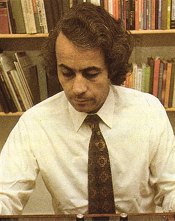Across the Atlantic in Great Britain, by contrast, medical researchers interested in pursuing radionics and other alternative health care modalities didn't have to face the same sort of persecution. Thus the next stages in the development of radionics took place there. The trailblazer in the British radionics scene was Dr. Guyon Richards, a respected physician, who was inspired by Albert Abrams' work to begin his own series of experiments. He published a book, The Chain of Life, in 1934. (It's long out of print and difficult to find; since Richards died in 1946 and his book is now out of copyright, it would be a good candidate for republishing.) His book and his experiments inspired other British researchers to turn their attention to radionics.
 The most influential of the second generation of British radionics researchers was the husband-and-wife team of Marjorie and George de la Warr. (That's Marjorie on the right, working with one of their radionics machines.) George was an engineer who became fascinated with radionics between the two world wars. At that time nearly all radionics gear was manufactured in the United States, and getting the necessary equipment overseas was expensive. De la Warr's response was to contact Ruth Drown and get a license to build machines using her design in Britain. De La Warr Laboratories soon became a major supplier of radionics equipment to British and European researchers and physicians.
The most influential of the second generation of British radionics researchers was the husband-and-wife team of Marjorie and George de la Warr. (That's Marjorie on the right, working with one of their radionics machines.) George was an engineer who became fascinated with radionics between the two world wars. At that time nearly all radionics gear was manufactured in the United States, and getting the necessary equipment overseas was expensive. De la Warr's response was to contact Ruth Drown and get a license to build machines using her design in Britain. De La Warr Laboratories soon became a major supplier of radionics equipment to British and European researchers and physicians.  The de la Warrs -- that's George on the left -- also went to work with the strangest of Ruth Drown's inventions, a camera that apparently took pictures at a distance through radionics. They scored some eerie hits: for example, using a drop of blood from a cancer patient, they produced a photo showing a tumor in his brain. When the patient died and was autopsied, the location and size of the tumor turned out to be correct. (This was long before CAT and MRI scans, remember.)
The de la Warrs -- that's George on the left -- also went to work with the strangest of Ruth Drown's inventions, a camera that apparently took pictures at a distance through radionics. They scored some eerie hits: for example, using a drop of blood from a cancer patient, they produced a photo showing a tumor in his brain. When the patient died and was autopsied, the location and size of the tumor turned out to be correct. (This was long before CAT and MRI scans, remember.) The tide of repression on the far side of the Atlantic didn't leave them entirley unscathed. In 1969 the de la Warrs were sued for fraud by a woman who bought one of their machines and claimed that it did nothing. The suit was thrown out of court, fortunately for the radionics community, but not before the de la Warrs were deep in debt. Even so, they escaped the fate of Drown, Reich, and too many other alternative health care pioneers in the US.
 The de la Warrs inspired many other British radionics practitioners, and helped launch a wave of innovation in the field. Among the leading figures in the movement were Malcolm Rae and Darrell Butcher, who devised radionics machines of their own designs and did extensive experimental work with them. Perhaps the most revolutionary work in the field, however, was done by Dr. David Tansley, a chiropractor who became interested in radionics in the 1960s. Tansley -- that's him on the right -- had an encyclopedic knowledge of esoteric philosophy and Asian mystical traditions, and he seems to have been the first person to explore the interface between radionics and these older ways of understanding and working with the life force. His many books on radionics helped guide other researchers and practitioners into a broader sense of what they were working with.
The de la Warrs inspired many other British radionics practitioners, and helped launch a wave of innovation in the field. Among the leading figures in the movement were Malcolm Rae and Darrell Butcher, who devised radionics machines of their own designs and did extensive experimental work with them. Perhaps the most revolutionary work in the field, however, was done by Dr. David Tansley, a chiropractor who became interested in radionics in the 1960s. Tansley -- that's him on the right -- had an encyclopedic knowledge of esoteric philosophy and Asian mystical traditions, and he seems to have been the first person to explore the interface between radionics and these older ways of understanding and working with the life force. His many books on radionics helped guide other researchers and practitioners into a broader sense of what they were working with. Today? Radionics is a thriving field in Britain, one of the recognized branches of alternative health care, with its own professional organization, the Radionic Association. Training courses and radionics therapy are freely available, and there are several manufacturers of radionics machines doing a steady business. Somehow, despite the claims of the medical industry and its government enablers on this side of the pond, people aren't dropping like flies as a result of using radionics -- quite the contrary, in fact -- and in general, the open British approach to alternative healing has proven itself, Maybe someday we can get equally sane policies in place over here.